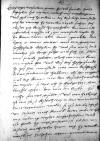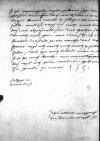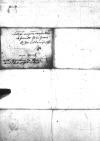Letter #5839
Johann Albrecht of Brandenburg-Ansbach to Ioannes DANTISCUSGhent (Gandavum), 1531-03-30
| received Antwerp, 1531-03-31 Manuscript sources:
Auxiliary sources:
| ||||||
Text & apparatus & commentary Plain text Text & commentary Text & apparatus
 AAWO, AB, D.90, f. [1] after f. 46
AAWO, AB, D.90, f. [1] after f. 46
Er paper damaged⌈[Er]Er paper damaged⌉wyrdige(m) meyne(m) wesundere(m) hern u paper damaged⌈[hern u]hern u paper damaged⌉nd freundt, hern
Zw eig paper damaged⌈[Zw eig]Zw eig paper damaged⌉nen hand(en)
Erwyrdiger wesunderer gutter her und freundt.
Euer schreyben hab ich von
Wy ir dan von euerem diner vernemen werdt, / so ist der probably
So ist
Andrest weys ich nichs neus elandt hidden by binding⌈[dt]dt hidden by binding⌉, das mir algesundt sein und horethen solch von euch auch gern. / Mit wunschung fil hunderdt dausendt gutter nacht und tag. Hymit wyl ich mich euch auch pefollen hidden by binding⌈[n]n hidden by binding⌉ haben. / Und pyt euch belledt mein wyrdt hidden by binding⌈[t]t hidden by binding⌉ , so er zu euch kombpt von meinetbege(n) grussen hidden by binding⌈[sen]sen hidden by binding⌉ das wyl ich gern verdinen.
Gebenn zu
Alzeyt in euerem dinst


